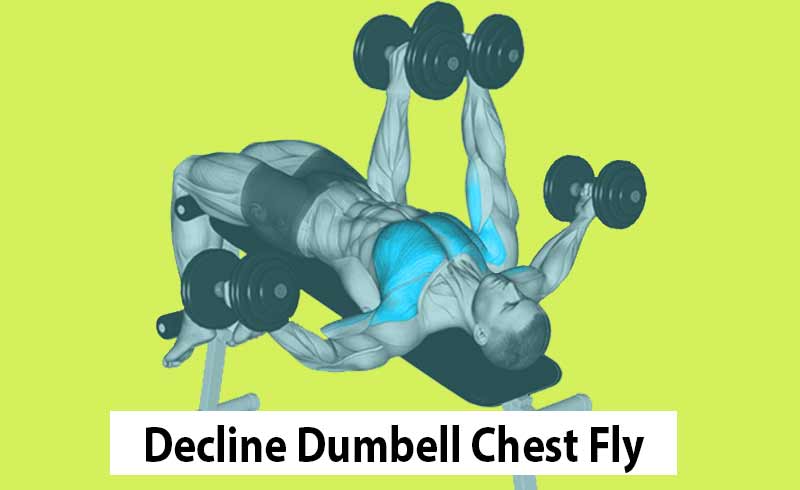Are you looking to sculpt a strong and defined chest? The decline dumbbell fly might just be the exercise you need!
In this guide, we’ll walk you through the correct form of performing this effective chest-building move as well as other important insghits lile muscles worked and the benefits.
So, whether you’re a beginner or an advanced trainer, you’ll find valuable tips and step-by-step instructions to help you perfecting your technique and maximize your lower pec gains.
Let’s dive right in!
What is the Decline Dumbbell Fly?
The decline dumbbell fly is a variation of the classic dumbbell fly exercise designed to target the lower part of your pectoral muscles.
While you can’t isolate specific sections of your chest muscle, you can apply extra tension to the fibers being worked, this makes it a fantastic exercise for overall chest development.
By using dumbbells, you engage stabilizing muscles and achieve a broader range of motion. When performed correctly, this exercise can significantly enhance your chest muscles without putting you at risk of injuries.
Muscles Worked During The Dumbbell Decline Fly
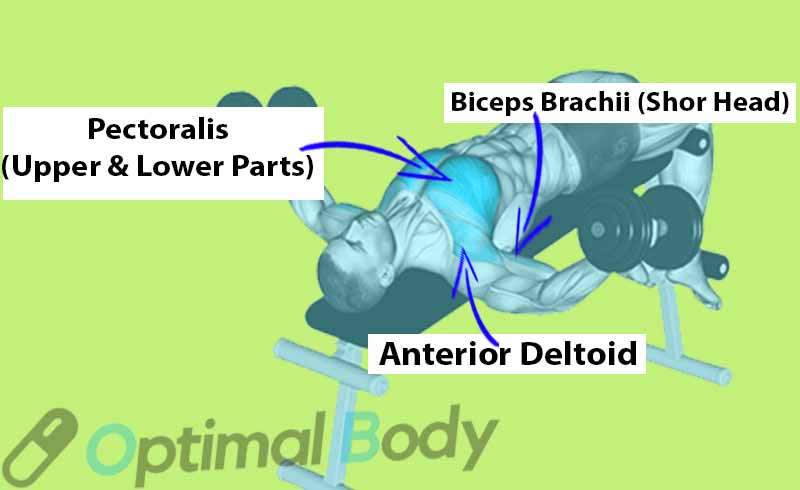
The decline dumbbell fly primarily targets the lower pectoral muscles, emphasizing the pectoralis major located in the central chest region. This muscle is key to achieving a well-defined and robust chest appearance.
Supporting the pectoralis major, synergist muscles play a vital role in executing the exercise effectively. The rhomboids stabilize the shoulder blades, while the levator scapulae aids in their elevation.
The anterior deltoids at the front of the shoulders assist in raising the arms, and the latissimus dorsi muscles in the back come into play during arm movement towards the body.
Additionally, the serratus anterior muscles wrapping around the ribs contribute to shoulder stability.
Complementary to these synergists, stabilizer muscles ensure balance and control throughout the movement.
The biceps brachii and brachialis assist in elbow bending, while the triceps brachii support elbow extension.
Wrist flexors, obliques, and the rectus abdominis all play roles in maintaining stability, rounding out a comprehensive set of muscles engaged during the decline dumbbell fly.
Benefits of the Decline Fly Using Dumbbells
Incorporating the decline fly into your workout routine brings a multitude of benefits that contribute to both aesthetics and functionality:
- Enhanced Lower Chest Development: The decline dumbbell fly is a potent tool for building thickness, muscle, and strength in the lower pectoral muscles.
- Fuller Chest Appearance: A well-developed lower chest contributes to the fullness and symmetry of your upper body.
- Extended Range of Motion: Compared to alternative chest exercises, the decline dumbbell flies offers a wider range of motion. This increased range enhances muscle engagement and can lead to more comprehensive development.
- Versatility in Workouts: The exercise can be tailored to various weight levels and variations, providing versatility to your workout regimen. This diversity challenges your muscles and promotes continuous growth.
- Improved Chest Mobility: The decline dumbbell fly can aid in opening up your chest muscles.
- Functional Strength: A stronger chest resulting from this exercise not only elevates your physical appearance but also contributes to daily activities and sports performance.
- Comprehensive Muscle Engagement: While the main focus rests on your chest, the decline dumbbell flie also effectively targets muscles in your shoulders, back, and arms.
- Minimal Equipment Requirement: One of the notable advantages is its simplicity. The decline dumbbell fly can be executed with minimal equipment. If a bench isn’t available, performing dumbbell flyes while lying on the floor is a viable alternative.
How To Do the Decline Dumbbell Flyes: Step By Step
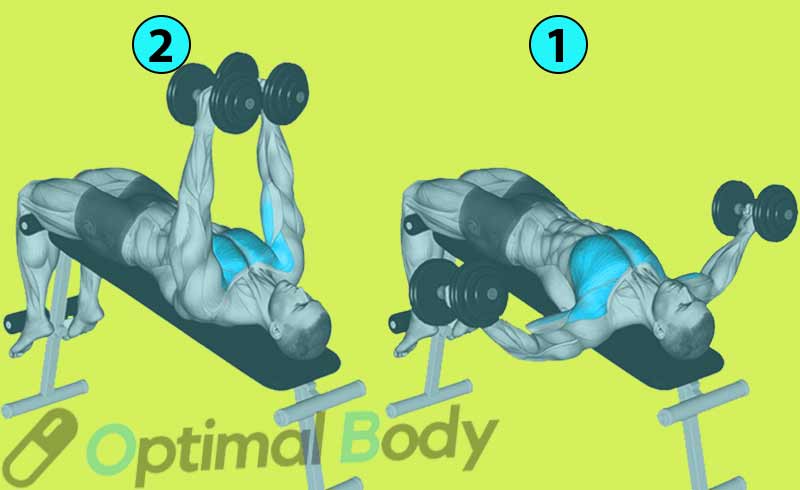
Step 1: Set Up
- Grab a pair of dumbbells with a neutral grip (palms facing each other).
- Position the dumbbells at the crease of your hips and sit down on a decline bench.
Step 2: Starting Position
- Lie back on the bench and keep the dumbbells close to your chest.
- Inhale deeply and lift the dumbbells up to the starting position.
Step 3: Execution
- Slightly retract your shoulder blades, unlock your elbows, and slowly lower the dumbbells to the sides while maintaining a consistent elbow angle.
- As the dumbbells reach chest level, reverse the motion by contracting your chest muscles and bringing the dumbbells back to the starting position.
- Keep a slight bend in your elbows and ensure you don’t let the dumbbells touch at the top of each repetition.
- Repeat the motion for the desired number of reps while maintaining mind muscle connection and continuous tension on your pectoral muscles.
Pro Tips:
- Bench Angle Matters: Try a medium tilt of about 30 degrees as extreme positions may not be suitable for everyone.
- Don’t Hold the Dumbbells Too Tight: Avoid gripping the dumbbells too hard. It might bring in your forearm and bicep muscles too much, which isn’t the goal.
- Keep the Squeeze: Don’t let the dumbbells touch at the top of the move. That way, your chest muscles stay engaged.
- Keep It Bendy: Always have a little bend in your elbows. And don’t lower the weights so much that your shoulders hurt.
- Tighten Your Tummy: Remember to use your tummy muscles a bit and don’t let your lower back arch too much.
- Add decline dumbbell flies to your chest workout routine: and you’ll see your chest muscles get stronger and more defined over time. Just remember: practice the right way and keep at it regularly to stay safe and get the best results.
Top 4 Decline Dumbbell Fly Variations To Do
1. Dumbbell Decline Twist Fly:
During this exercise, avoid letting the dumbbells touch at the top to keep the tension on your chest.
How To Do:
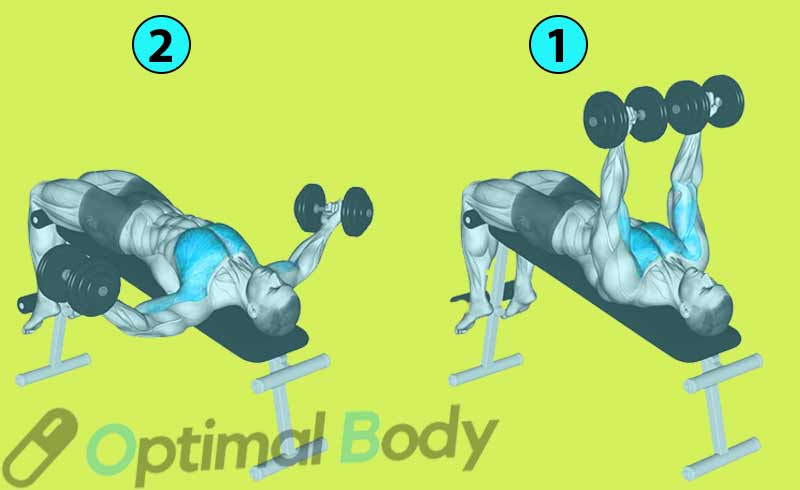
- Lie on a declined bench with a dumbbell in each hand.
- Hold the dumbbells in front of your shoulders with your elbows slightly bent.
- Slowly lower the dumbbells out to the sides while keeping your elbows bent.
- As you bring the dumbbells back up, twist them so they almost touch at the bottom.
- Don’t let them touch, keep a little space between them.
- Repeat the movement, untwisting the dumbbells as you start each new rep.
2. Decline Crossover Dumbbell Flyes:
Keep your movements controlled and steady throughout this variation.
How To Do:
- Lie down on a decline bench with a dumbbell in each hand, palms facing each other.
- Extend your arms above your chest, with a slight bend in your elbows.
- Lower one arm diagonally across your body while keeping a slight bend in the elbow.
- Stop when your hand is slightly below chest level or feels a good stretch in your chest.
- Bring the dumbbell back up to the starting position, focusing on your chest muscles.
- Alternate between both arms for each repetition.
3. Single-Arm Dumbbell Decline Flye:
Here is a tip for you, always start with the weaker side of your chest for this varaiation.
How To Do:
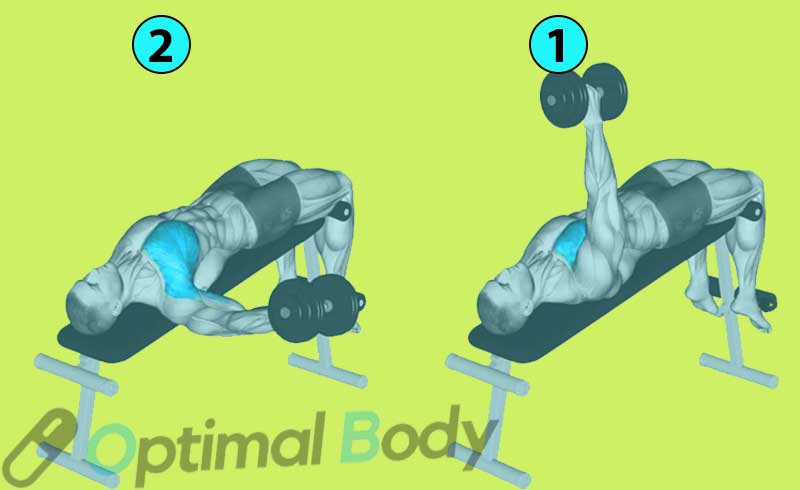
- Lie down on a bench that’s declined.
- Hold a dumbbell in one hand above your chest.
- Slowly lower your arm with the dumbbell out to the side.
- Stop when your wrist is about level with your shoulder or a bit higher.
- Bring your arm back to the middle, using your chest muscles to bring it in.
- Repeat for the desired number of reps and sets.
4. Decline Dumbbell Pullover:
This exercise also engages your back muscles, giving you a well-rounded workout.
Focus on maintaining stability and control throughout the whole movement.
How To Do:
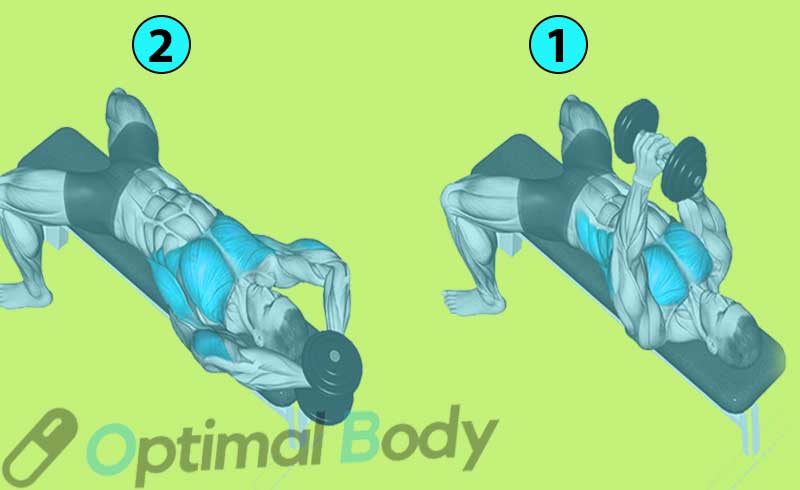
- Lie down on a decline bench with your hips lower on the bench, and feet secured.
- Hold a single dumbbell with both hands above your chest, arms extended.
- Lower the dumbbell back behind your head in a semi-circular motion while keeping a slight bend in your elbows.
- Feel a stretch in your chest and upper back as the dumbbell goes down.
- Pull the dumbbell back up to the starting position using your chest muscles and repeat.
Best Alternative To Dumbbell Flye Declined
1. Smith Machine Decline Press
2. Decline Cable Press
3. Cable Fly In A Seated Position
Here Are More Alternative that targets the same muscle groups:
- Incline Push-ups
- Decline Dumbbell Bench Press
- Sliding Pushup
- Dips
- Cable Crossovers
- TRX Push-Ups
Conclusion
Decline dumbbell flies are a super exercise to give your chest muscles a boost, especially the lower part.
Follow the simple steps and pro tips in this guide, and you’ll become a pro at this exercise.
As you practice and get better, you can even increase the weights to challenge yourself more.
So, have fun and enjoy getting stronger!
References:
- Reiser, Fernando & Lira, Jumes & Bonfim, Beatriz & Filho, Solival & Durante, Bruno & Cardoso, João & Miotto, Hamilton & Soares, Marcos & Bonuzzi, Giordano & Tavares, Lucas. (2017). Electromyography of Dumbbell Fly Exercise Using Different Planes and Labile Surfaces. Journal of Exercise Physiology Online. 20. 31.
- Krzysztofik M, Wilk M, Wojdała G, Gołaś A. Maximizing Muscle Hypertrophy: A Systematic Review of Advanced Resistance Training Techniques and Methods. Int J Environ Res Public Health. 2019 Dec 4;16(24):4897. doi: 10.3390/ijerph16244897. PMID: 31817252; PMCID: PMC6950543.
Solstad TE, Andersen V, Shaw M, Hoel EM, Vonheim A, Saeterbakken AH. A Comparison of Muscle Activation between Barbell Bench Press and Dumbbell Flyes in Resistance-Trained Males. J Sports Sci Med. 2020 Nov 19;19(4):645-651. PMID: 33239937; PMCID: PMC7675616.
- Bench Press Calculator - April 22, 2024
- Press to Handstand: Ultimate Step-by-Step Guide - April 22, 2024
- Cable Press (How To Do, Benefits, Targeted Muscles, Alternative) - April 22, 2024

